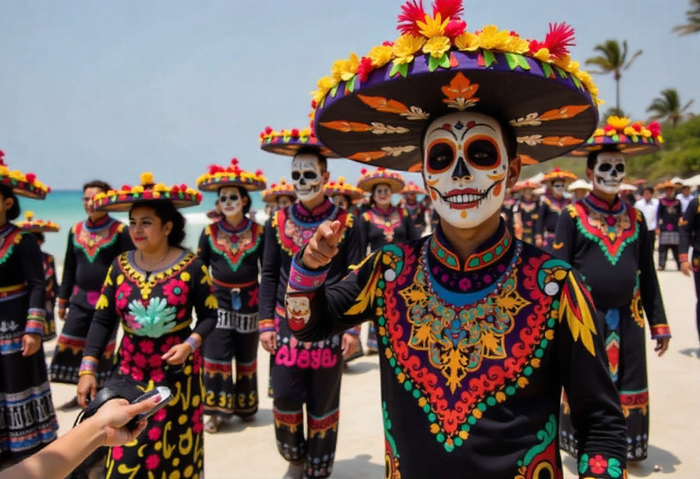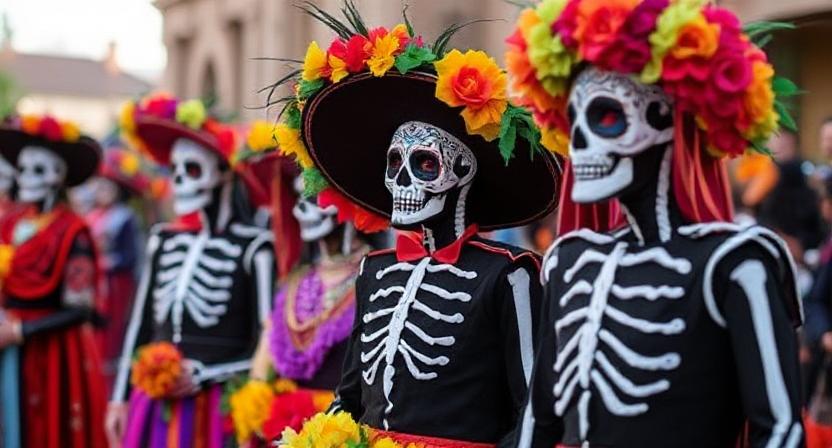Cancun, Riviera Maya, Mexico City, Guadalajara, Monterrey, And Quintana Roo Record Powerful Visitor Surge As Mexico Day Of The Dead Celebrations Ignite Cultural Tourism Fever

Cancun, Riviera Maya, Mexico City, Guadalajara, Monterrey and the wider state of Quintana Roo are experiencing a dramatic rise in visitor numbers as Mexico enters its most anticipated cultural season of the year. The world-famous Day of the Dead festivities have turned these destinations into immersive cultural arenas filled with symbolic rituals, vibrant altars, traditional dances and colorful parades. From October 27 to November 2, both domestic and international travelers are arriving in record numbers to experience a celebration that blends ancestral belief with emotional depth and visual spectacle.
Tourism momentum has climbed sharply as rising global interest in cultural travel aligns with Mexico’s enhanced air connectivity, strengthened hotel infrastructure and powerful international promotion. Official tourism data projects around 1.6 million hotel rooms will be occupied during the Día de Muertos period, representing a 2.3 percent increase over the previous year. This surge highlights not only the economic value of Mexico’s cultural heritage but also its ability to attract high-volume tourism through meaningful and authentic experiences rooted in history, identity and tradition.
According to official tourism estimates, 73 percent of these reservations are being made by domestic travelers, reflecting strong national interest in maintaining cultural traditions, while 27 percent of bookings come from international visitors. The figures show that global fascination with Mexico’s spiritual heritage continues to grow, especially around Día de Muertos, a colorful and symbolic celebration designated by UNESCO as an Intangible Cultural Heritage of Humanity.
A Celebration That Captivates the World
The Day of the Dead is far more than a holiday in Mexico – it is a ceremony of remembrance and love, honoring ancestors through altars, candles, marigold flowers, and artistic tributes. Rather than mourning death, families celebrate the cycle of life with joy, music, traditional cuisine, and offerings believed to guide the souls of loved ones back to the world of the living.
This year, tourism authorities are emphasizing the cultural depth and emotional resonance of the celebration, noting its growing ability to connect with international visitors seeking meaningful travel experiences. Many travelers are choosing Mexico not just for beaches and resorts, but to immerse themselves in authentic cultural identity and ancestral tradition.
Major Tourism Destinations Expect High Occupancy
While Día de Muertos is observed nationwide, several destinations are emerging as hotspots for travelers during this year’s festivities:
| Destination | Expected Tourism Role |
|---|---|
| Cancún | Leading hotel bookings, cultural shows and beachfront altars |
| Riviera Maya | Popular with families, archaeological tours and themed events |
| Mexico City | Hosts the famous Day of the Dead Parade and mega-offerings |
| Guadalajara | Combines mariachi heritage with traditional cemetery tributes |
| Monterrey | Offers large cultural festivals and open-air performances |
Tourist routes combining cultural immersion with scenic exploration are gaining popularity. Heritage towns like Pátzcuaro, Oaxaca, San Miguel de Allende, and Janitzio Island are also seeing strong visitor interest due to their visually stunning and deeply communal celebrations.
Quintana Roo Highlights Mayan Heritage With Janal Pixan
In the Caribbean state of Quintana Roo, the Day of the Dead takes on a special cultural form through the Mayan tradition known as Janal Pixan, which translates to “Food for Souls.” This regional variant blends ancient spiritual beliefs with colonial rituals, offering a unique cultural experience that many tourists are eager to explore.
Festivities will take place in Cancún from October 30 and 31 to November 1 and 2, featuring family altars, traditional gastronomy, music, and theatrical performances honoring ancestral spirits. One of the most anticipated events in Cancún will be a multi-day cultural performance in Puerto Juárez, titled “Puerto de los Suspiros” (Port of Sighs), which is expected to attract thousands of local and visiting spectators.
Tourism Industry Mobilizes for Cultural Promotion
Mexico’s tourism sector is positioning Día de Muertos as a global cultural attraction, using media campaigns and immersive experiences to promote the holiday to international travelers. Tourism leaders highlight the celebration not only as a cultural treasure but also as a major economic driver that supports local artisans, traditional performers, indigenous communities, and family-owned businesses.
Craft markets, ancestral rituals, folkloric dance troupes, and cultural showcases are being integrated into tourism strategies across all 32 Mexican states. Government tourism departments have also emphasized the importance of safeguarding indigenous customs while expanding their reach to new generations and global audiences.
Hotels and Airlines Respond to Demand
To meet the surge in travel demand, hotels and resorts across major tourist zones have introduced special packages that include cultural tours, altar-building workshops, cemetery visits, and Day of the Dead banquets featuring traditional dishes like pan de muerto and mole. Airlines operating flights from North America, Europe, and South America have reported increased seat capacity on routes to Cancún, Mexico City, and Mérida during the holiday period.
Many tourism operators anticipate that this year could see record spending levels, as travelers are increasingly seeking experiential tourism – trips that offer emotional connection, cultural education, and authentic interaction with local communities.
A Legacy Beyond Borders
Across Mexico, preparations are underway not only to welcome visitors but also to restore cultural pride. The Day of the Dead continues to transcend generations, preserving indigenous roots and storytelling traditions that reflect Mexico’s view of life as a sacred journey. For many locals and visitors alike, the holiday is a reminder of shared humanity, memory, and spiritual continuity.
With traveler interest rising worldwide and festive programming expanding each year, Mexico’s Day of the Dead stands as one of the most powerful cultural tourism experiences on Earth – a celebration where tradition, emotion, and identity meet.
The post Cancun, Riviera Maya, Mexico City, Guadalajara, Monterrey, And Quintana Roo Record Powerful Visitor Surge As Mexico Day Of The Dead Celebrations Ignite Cultural Tourism Fever appeared first on Travel And Tour World.